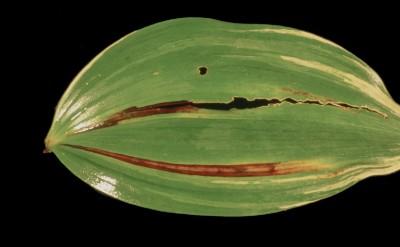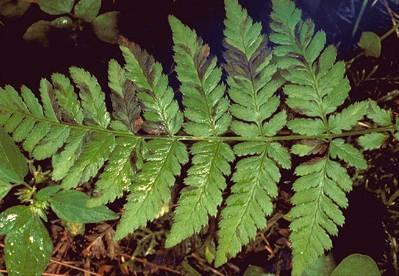Foliar nematodes
- All of the nematodes that cause plant diseases are very small (0.5 to 0.75 mm), colorless roundworms. Microscopic examination is required to identify these tiny worms. Most of these nematodes reside in the soil and feed on the plant roots. A few plant parasitic nematode species live in shoots and leaves. Some nematodes also serve as vectors for plant virus diseases such as tomato ring spot and tobacco ring spot. These viruses are frequently found infecting herbaceous perennials, causing stunting, decline, ring spots and foliar mosaic symptoms.
- Several nematodes do not infect roots or reside in soil. Rather they live in and damage the shoots and foliage. The foliar nematode (Aphelenchoides) is very common in herbaceous perennials. It causes foliar discoloration and blight that is usually bounded by major leaf veins. On monocots (tend to have parallel leaf venation) such as lilies, hostas, and iris, this appears as stripes or rectangular panels. On dicots (tend to have net leaf venation) such as anemone, ligularia, and peony the discolored areas look like a patchwork of discolored (purple, yellow, tan) areas. The discoloration eventually progresses to a leaf blight, progressing from oldest foliage to younger foliage.
- Foliar nematode (Aphelenchoides) produces off color areas in foliage that progress to leaf blight by mid to late summer. The most common species found in herbaceous perennials is the strawberry leaf nematode (Aphelenchoides fragariae). This nematode is found in nature throughout the temperate regions of the world, and is very common in woodland plants collected from the wild. Other species of foliar nematode attack chrysanthemum and rice
- Early in the season the foliar nematode feeds externally on young shoots and leaf tissues, producing stunting, twisting, curling and spotting. Soon they enter the leaf where they remain throughout the growing season feeding on the spongy mesophyll cells. The nematodes cannot move past main leaf veins while inside the leaf; therefore the symptoms are seen as discoloration clearly bounded by the leaf vein. During wet weather, the nematodes can crawl around on the plant in a film of water, and enter new leaves through the stomates. In monocots such as hostas and lilies, damage symptoms appear as stripes. In dicots, which have net like vein patterns, the symptoms look like a patchwork.
- Foliar nematodes attack a broad variety of plants including ferns, peonies, begonias, anemones, baptisia, Hepatica, Heuchera, hostas, Hypericum, moon vine, iris, lilies, Ligularia, orchids, Oriental poppy, phlox, Polygonatum, Rogersia, salvias, and Tricyrtus. A woody plant that can be infected with foliar nematode is azaleas. The foliar nematode can easily spread from these woody hosts into herbaceous ones.

Foliar nematode symptoms on hosta. Photo: Jonathan D. Eisenback, Virginia Polytechnic Institute and State University, Bugwood.org

Foliar nematode symptoms on anemone. Photo: Ellen Ellen Hartranft

Symptoms on fern. Photo: R. Mulrooney
Stem and bulb nematode
- The stem and bulb nematode (Ditylenchus) produces twisted, stunted, very odd looking growth, with symptoms often starting early in the season. When bulbs are infected, the bulbs will rot with the rot at first confined to individual bulb scales. Stem and bulb nematode is often found on phlox, tulip, narcissus, and hyacinth but many other crops and weeds can support this nematode. The stem and bulb nematode (Ditylenchus dipsaci) can infect many ornamental bulbs and other ornamentals such as phlox. Infected bulbs have distorted leaves and browned bulb scales. Phlox shows distorted growth, stunting and plant death when infected with stem and bulb nematodes. Large numbers of nematodes may be present in symptomatic plant tissues and can be seen with the microscope as a writhing white mass called "nematode cotton".
- The stem and bulb nematode (Ditylenchus dipsaci) and the foliar nematode (Aphelenchoides fragariae) feed primarily on foliage, and are detected by microscopic examination of foliage or bulbs, not roots and soil. They are usually introduced in infected plants, but can spread to other plants during production.
Typical biology of nematodes
- Nematodes develop from eggs through several larval stages, eventually to become adults. Some nematode genera have unusual life cycles and males are not always needed for reproduction. The lesion nematode (Pratylenchus) feeds inside the root moving about inside the root. Foliar nematode and stem and bulb nematode have many generations overlapping inside the plant tissues, with immatures and adults of both sexes present.
Monitoring and control
- Late summer and fall are the best to see foliar discoloration caused by the foliar nematode. In the landscape the symptoms appear late in the growing season and are relatively mild, so usually most infected plants perform well and need not be removed.
